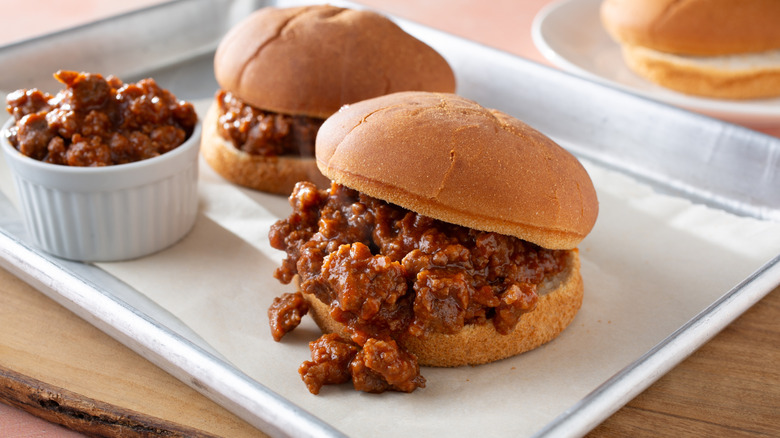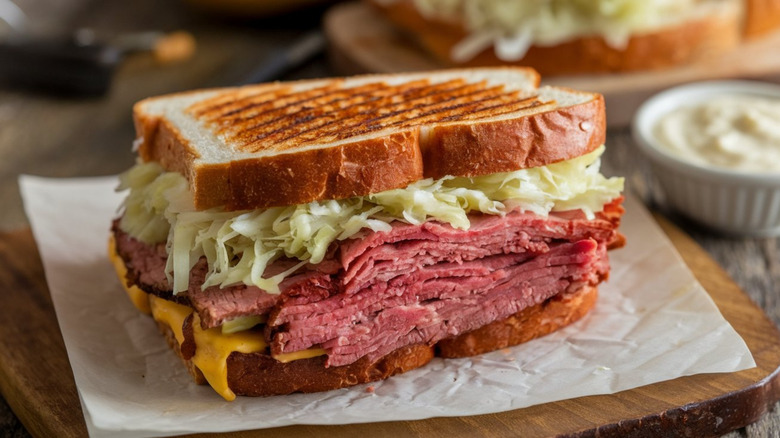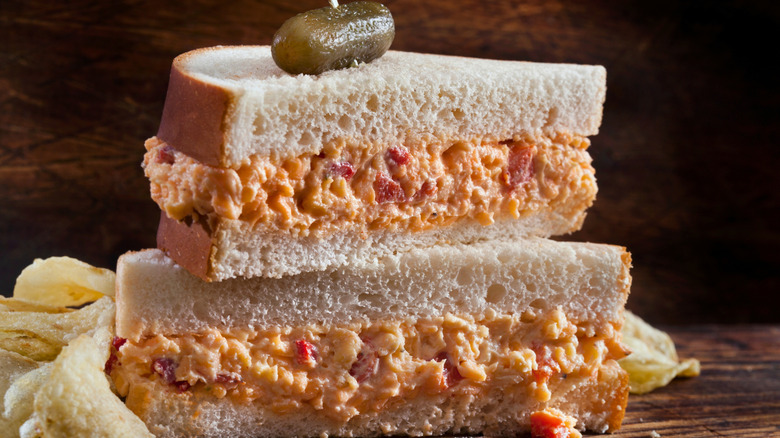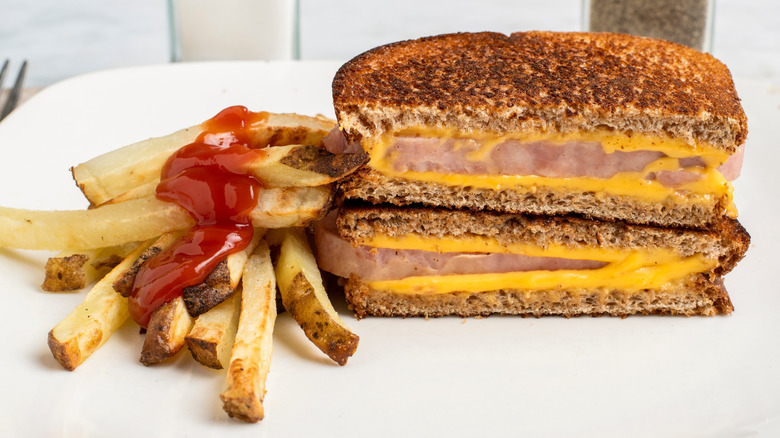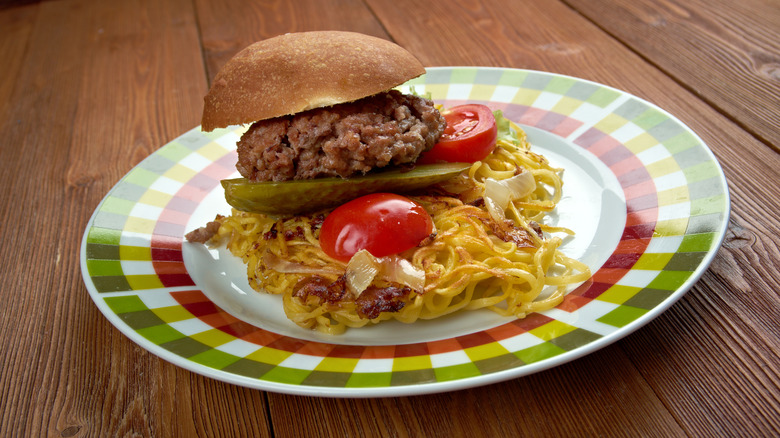7 Throwback Sandwiches From The 1950s
Since the first invention of the sandwich at a card table in the 18th century, people have continually tried to create the most lavish, the most intricate, and the most satisfying sandwiches that they can imagine. But no era was as experimental with its combinations of bread and fillings as the first years after World War II. Whether inventing their own stacks of savory flavor or adopting previous decades' stylish bites as their own, food lovers of the '50s really did embrace all kinds of delicious (and in some cases bizarre) lunch specials.
You can still find almost every sandwich on this list prominently placed on menus somewhere in America, which proves just how much staying power these culinary marvels have. Some of them have become so omnipresent that it's impossible to find a diner that doesn't serve them. You can thank the 1950s for so many of the sandwiches we have today, as well as a few more obscure offerings that may make you want to try some new recipes when you have a lunchtime hankering.
Monte Cristo
A question for (hungry) philosophers is whether the Monte Cristo is a product of classic French indulgence or 1950s American indulgence. The origins of this sandwich — a combination of a turkey sandwich, a ham and cheese sandwich, and French toast with a dusting of powdered sugar on top — lie somewhere between both cultures, with a little Walt Disney magic thrown in for good measure.
Food historians trace the Monte Cristo's lineage to the croque monsieur, a French take on the grilled cheese, which appeared sometime in the early 20th century. The croque monsieur (roughly translated as "Mr. Crunch") is no stranger to indulgence itself: it features layers of ham and cheese with a topping of bechamel sauce. But only in America could such a sandwich become a lavish breakfast-and-dinner-food mashup.
It's generally believed that the Monte Cristo first appeared in the margins of cookbooks in the 1930s but only got its iconic name in Southern California in the '50s, although there's little physical evidence to back this up. Then, in the 1960s, Monte Cristo sandwiches got another boost when they started being served in the happiest place on Earth, Disneyland. You can still find this '50s favorite there today.
Sloppy Joes
Ah, the legendary cafeteria staple: ground beef swimming in a sweet, tangy, and savory sauce, piled atop a sandwich roll woefully ill-prepared to absorb that much liquid. Yet while it is a messy and oft-beloved nostalgia trip for the tastebuds, it's also surprising just how much history lies behind the Sloppy Joe.
The origins of the Sloppy Joe are shrouded in myth. Is it an evolution of loose meat sandwiches from the 1920s? Or is it a Cuban invention from Florida restaurants, including one saloon actually called Sloppy Joe's? Or perhaps the sandwiches are named after a particular kind of restaurant from the 1930s? Regardless, it wasn't until the late 1940s and early 1950s that Sloppy Joes took on the prominence that makes them instantly recognizable today, with articles about their omnipresence as a school cafeteria food appearing in 1957. However, it was more than a decade before the most famous consumer Sloppy Joe sauce, Manwich, first appeared on the market in 1969. Before then, you had to make it from scratch.
Reuben sandwich
The debate about when the Reuben sandwich was first invented, and more crucially, who invented it, rages on even now. Calling it "contentious" might be an understatement.
Was the Reuben sandwich first invented at the Blackstone Hotel in Omaha, Nebraska, in the 1920s and named for one of the owner's friends? Or was it instead invented in New York City in 1914 and named after sandwich shop owner Arnold Reuben? The two stories have virtually no overlap. What doesn't seem to be in contention is that, in 1956, a waitress associated with the Blackstone Hotel named Fern Snider submitted the Reuben sandwich — which consists of corned beef, sauerkraut, Swiss cheese, and Russian dressing on rye — to a national sandwich idea contest. It won outright and became a national sensation.
That would seem to confirm the Omaha story, but defenders of the New York origin story say the sandwich was already a regional delicacy prior to this. No matter who is correct, what matters is that from the 1950s and beyond, Reuben sandwiches (not to be confused with Rachel sandwiches) have remained a hearty lunchtime favorite.
Pimento cheese sandwich
Some sandwiches have beginnings mired in ambiguity and argument. And then there is the pimento cheese sandwich, whose origins are so clear they actually prove more surprising to some sandwich connoisseurs.
Much like the Arnold Palmer, this sandwich's history is tied up with golf. In the late 1940s, Hodges and Ola Herndon, a husband-and-wife concession stand team at the Masters Golf Tournament, made the first pimento cheese sandwiches at home. They then brought them to the competition, where the snacks immediately sold like hot cakes. It makes sense: spicy and creamy pimento cheese between two slices of white bread not only makes a delicious sandwich but also a handheld meal that keeps well and transports easily, making it great for eating on the go (for example, during a golf tournament). The sandwiches became a smash sensation in the 1950s and, thanks to their popularity in the world of golf, you can still get a pimento cheese sandwich at the Masters to this day.
SPAM sandwich
We can thank the G.I.s for the prevalence of SPAM sandwiches in the 1950s. SPAM, the canned spiced pork product popular enough to have a Monty Python song about it, was a huge deal during World War II. SPAM can keep for years even without refrigeration and is calorie-dense, which makes it an ideal ration for soldiers fighting away from home.
Even after the soldiers returned at the end of the war, SPAM remained beloved for being relatively inexpensive and convenient. And one of the favorite ways to eat SPAM in the 1950s was in sandwich form. Thick-sliced, pan-fried, and topped with cheese, eggs, or maybe even baked beans, SPAM sandwiches are simple but hearty and very tasty. SPAM might not have as much prominence in American cuisine as it once did, but it's still beloved in some places, especially Hawaii. You can even attend the SPAM festival if that floats your tastebuds' boat.
Chow mein sandwich
On the surface, the chow mein sandwich may not seem like much. It's literally crispy chow mein noodles, vegetables, and ground pork smothered in American gravy piled on a bun. Yet this sandwich, first popularized en masse in the 1950s but invented decades earlier, has a sweet history of cultural fusion.
In Fall River, Massachusetts, an influx of Chinese immigrants in the late 1800s arrived and began opening laundromats, tea shops, and eventually restaurants. To help introduce the then-mostly European immigrant population to a new cuisine, the owners of these restaurants used the chow mein sandwich to cross cultural boundaries, creating an unfamiliar but delicious dish made to combine different culinary sensibilities. As an added benefit, a sandwich proved to be a very effective means for factory workers to bring a filling noodle dish with them for lunch. It proved to be wildly successful, breaking out of New England in the following decades and remaining a favorite across some parts of the country to this day.
Frosted sandwich loaf
You remember when people on the internet started debating if pizza was a sandwich, and things got kind of heated? Well, turns out that was child's play compared to this retro relic of the 1950s. It's called a frosted sandwich loaf, but admittedly, it stretches the definition of "sandwich" right to the breaking point.
On the one hand, it is definitely an actual sandwich. It has slices of bread, and between those slices of bread are actually multiple fillings, such as bacon, pickles, butter, pimento peppers, egg salad, chicken salad, etc. The fillings are remarkably varied. What unites all frosted sandwich loaves is the "frosting" on the outside, which is actually a chilled cream cheese and mayo mixture. Some '50s home chefs really went the full mile and decorated these savory "cakes" to look like their sweet counterparts, or went elaborate with toppings like decoratively sliced cucumbers. These sandwiches were once the toast of high-class home celebrations, but their heaviness and general changing tastes meant that they fell out of fashion, and joined the ranks of sandwiches you just don't see anymore.



